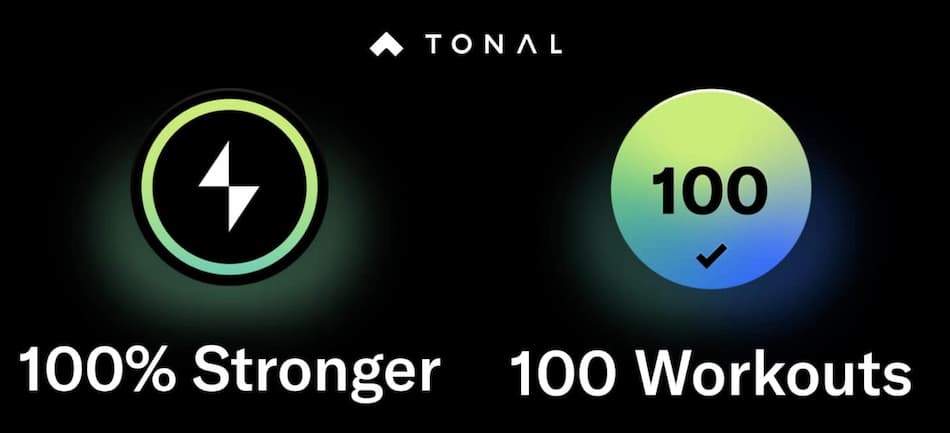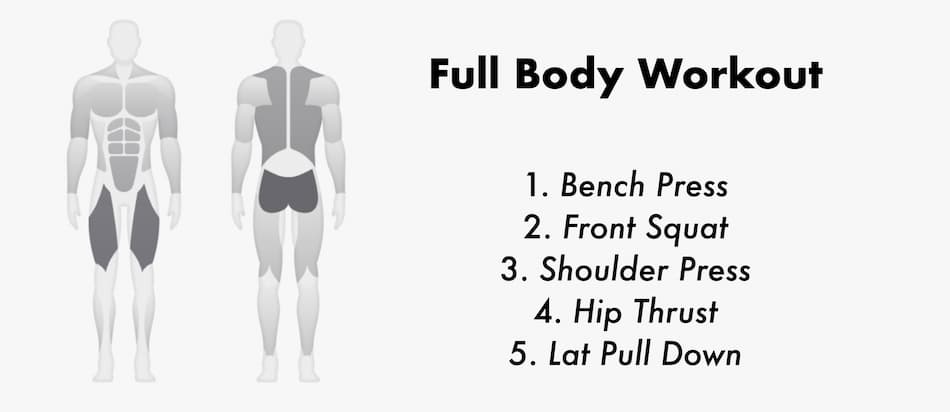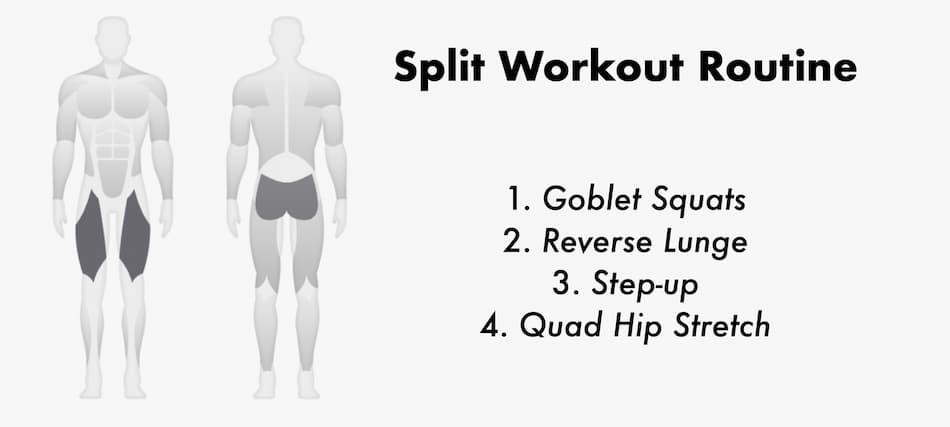I’ve been using Tonal gym religiously for over two years with me and my clients. Needless to say, we went through hundreds of workout programs, as well as created some really cool custom training plans.

Today I wanna share with you the best Tonal workout program to build muscle and burn fat if you just wanna do your own thing.
As a whole, the Tonal gym is a good workout because it has thousands of workouts for all fitness levels. It also allows you to do over 200 exercises that target the muscles from different angles – horizontal, vertical, and lateral, with a max resistance of 200 lbs.
What Is The Best Tonal Workout Program?
There are multiple ways to do Tonal workouts in terms of routines. In general, you have upper/lower split, push-pull split, Arnold split, and full-body workout.
Each of these workout types has its time and place, and it should be used based on your fitness level.
For example, people who are just getting started with Tonal and don’t have previous resistance training experience, or who haven’t been training in the gym for a very long time would probably get better results from full-body workouts.
I also believe that a full-body workout would be the perfect option for seniors.
On the other hand, people who are skillful in the gym and have a flexible schedule that allows them to train 5-6 days per week could benefit from doing split training.
So choosing your Tonal workout program should be based on your individual lifting experience, as well as training intensity, training frequency, overall goals, and personal preferences.
Tonal full-body workout
The best Tonal workout program for beginners is a full-body workout becasue doing one exercise per muscle group in each training session is enough to provide sufficient stimulus and be able to see the progress.
Not only that.
Some studies have shown that training the upper body 3 times per week with a single set per exercise (1 set of 10 reps) had similar strength and hypertrophy results as doing multiple sets (3 sets of 10 reps) in untrained people.
Bent R Rønnestad, Ph.D., a Professor in Exercise Physiology from Inland Norway University of Applied Sciences, said that there is a significant difference between 1 set vs 3 sets on leg muscle, however, not for the upper body.
Keep that in mind.
Related: Click here to learn more about what are the best Tonal leg workouts.
Below you can see the example of a Tonal full-body custom workout.

As you can see in the picture above, this particular workout has 5 exercises and cover all muscle groups.
Each exercise focuses on one muscle group.
Bench hits your chest, squats hit your quads, shoulder press hits your delts, hip thrusts target the posterior chain, and lat pulldown works on your back.
Based on numerous studies, as well as my experience from working with different people on a long-term basis, beginners don’t need to do more in order to see progress.
Tonal workout split
For more advanced people who already developed a significant amount of muscle mass, but reach the workout plateau and seek to continue making progress, doing one exercise per muscle group may not be enough anymore.
These peeps need to either increase the training frequency (number of days you train per week) or change their workout routine that will allow hitting muscles harder.
They may need to do 2-4 different exercises on the same muscle group per workout to further stimulate muscle growth.
See the example below.

Here you can see the whole workout session is designed to train legs. All four exercises are for the lower body, which will induce much higher mechanical tension and metabolic stress. This means better muscle gains, but at the same time, higher muscle soreness.
Beginners who do this type of workout using high intensity, reps to failure, and advanced training methods like eccentrics would require significantly more time to recover from the muscle soreness.
Unlike beginners, advanced lifters have already adapted their bodies to become more efficient in eliminating metabolites from the aching muscles that are causing this uncomfortable stiffness. Therefore, they can handle this workout intensity and training style.
Make sense? I hope so.
Okay, let’s dig into the workout plans.
Best Tonal Workout For Beginners
One of the best ways to build muscle and burn fat on Tonal is to do a full body workout becasue it promotes a higher frequency of training all muscle groups within one session. It also helps to burn more calories in a shorter period of time.
In his article, Brad J Schoenfeld, Ph.D., a researcher from New York City, states “frequencies of training twice a week promote superior hypertrophic outcomes to once a week“.
This means that the more frequently you train the muscle, the more it’ll grow (assuming that you train with optimal training volume).
For example, doing tonal bench press 3-4 times per week stimulates muscle hypertrophy better, compared to once per week.
When it comes to calories, full body wokrouts that prioritize compound exercises like bench, squats, deadlifts, and rows engage more muscle groups, recruit more muscle fibers, and hit a higher percentage of the total motor units.
Therefore, it is better at burning calories and promoting fat loss.
Joel Marion, a co-founder of BioTrust Nutrition and an author for T-Nation, said that full-body workouts will yield a greater energy expenditure per workout when compared to split routines because of the large amount of muscle mass being taxed in each session.
How to choose exercises for the Tonal workout plan?
When choosing the exercises for your Tonal workout plan you need to keep in mind that each movement is there to elicit a specific outcome.
For example.
- The compound moves like deadlifts, squats, and bench are usually done with heavy resistance and low rep range to stimulate muscle damage.
- The isolation exercises like glute bridges or lateral raises are performed with high rep range, but lower resistance where your goal is to induce metabolic stress aka “chase the burn”.
See the table below.
| High Load / Low Reps | Low Load / High Reps |
|---|---|
| Bench Press Back Squat / Front Squat Hip Thrust Deadlift Military Press Pull Down Bent Over Row | Front Raise Chest Fly Skull Crusher Biceps Curl Shoulder Rotation Pull through Glute Bridge |
The best Tonal workout will have a good combination of exercises from both groups.
- The first part of your workout should include 2-3 compound moves where you add more resistance (70-90% of 1RM), but you perform a low rep range (6-10 reps) of each exercise.
- The second part of your workout should include 2-3 isolation exercises where you reduce resistance (30-50% of 1RM), but you perform as many reps as possible.
Hit each muscle group twice per week
A well-balanced Tonal workout plan should hit each muscle group at least twice per week. If you have 3 workouts per week, this means you should do chest exercise in 2 out of 3 workouts. The same with other muscle groups.
For example, on Monday you can do barbell bench press, and on Friday you can do cable flyes. If you want to further develop your pecs, you can hit this muscle each time you train.
This help to maximize the strength and hypertrophy growth, as well as minimize muscle fatigue.
Below you can find 3 different full-body workout plans for Tonal gym.
Tonal Workout 1
Back Squat
Back squats are also called barbell squats, and they consist of standing with a barbell on your shoulders, squatting down, and coming back up. They work the quadriceps, hamstrings, glutes, and other muscles in your legs.
They also help to improve overall balance and coordination. This exercise is important for building muscle and strength because it uses multiple muscles at the same time.
- 4 sets
- 6-10 reps
Bench Press
The Tonal bench press works the chest, shoulders, and triceps muscles. It also helps improve your posture and performance during other exercises. A good alternative to the Tonal bench press is the cable chest press becasue it doesn’t restrict your range of motion as much.
- 4 sets
- 6-10 reps
Glute Bridge
The glute bridge is a compound exercise that trains both the Gluteus Maximus and the Gluteus Medius muscles. It is often used as a hip thrust workout accessory.
The reason why I like this exercise is that it helps to focus mainly on the glutes, and it does not target quads or hamstrings as much as other exercises do.
- 3 sets
- 15-25 reps
Seated Row
A seated row is a great way to work your upper body. It helps you build strength and endurance in your back, shoulders, and traps. This is a great alternative exercise for chin-ups that hits the back muscles from the horizontal plane.
- 3 sets
- 15-25 reps
Tonal Workout 2
Chin Up
Tonal chin-ups are not your typical pull-up variations where you lift yourself up from the floor. However, it is still a great way to strengthen your upper body, improve shoulder stability, and build strength in your biceps.
With chin-ups, I recommend using higher weight and low rep range, as well as playing around with advanced training methods like tonal eccentric mode or chains.
- 4 sets
- 6-10 reps
Hip Thrust
Tonal hip thrusts are one of the most effective exercises you can do to build your glutes. The difference between Hip Thrusts and Glute Bridges is that Hip Thrust offers a greater range of motion and higher muscle tension at the end range of the hip extension.
The best thing about glute training is this not only helps to make your butt muscle pop but also transfers into other exercises, as well as makes you more mobile and functional human being.
- 4 sets
- 6-10 reps
Chest Flies
Cable chest flyes are the only chest exercise you can do on Tonal that allows you to hit the clavicular pectoralis and make your upper pecs pop. This exercise is also good to be done with high reps to increase metabolic stress and lactate build-up.
- 3 sets
- 15-20 reps
Lateral Raises
The shoulder lateral raise is a basic exercise that is best to be done with low resistance and high reps. This exercise targets your delts, which are responsible for shoulder abduction and external rotation.
Lateral shoulder raises can also be used to improve overall shoulder mobility. The number of lateral shoulder raises you to do depends on the individual, but 15 to 20 reps is generally adequate.
- 3 sets
- 15-20 reps
Tonal Workout 3
Deadlift
This is another great hip hinge exercise that targets glutes, hammies, and lower back muscles.
The tonal deadlift is one of those exercises that you need to really have good form because if it’s done incorrectly, it will put pressure on your lower back, not on the glutes. Tonal cable deadlift can be done with low reps and high resistance.
- 4 sets
- 6-10 reps
Shoulder Press
The shoulder press is a compound exercise that works the following muscles: deltoid, pectoralis major, pectoralis minor, trapezius, and core muscles of the abdomen and lower back. It is also a great exercise for increasing shoulder range of motion.
- 4 sets
- 6-10 reps
Lunges
A lunge is a low-impact exercise that targets the quadriceps, hamstrings, glutes, and calves.
You stand with your feet hip-width apart, then lower your hips until your thighs are parallel to the ground. Keep your back straight and shoulders down throughout the movement.
Tonal has several lunge variations, so feel free to mix things ups to prevent your workout from getting boring.
- 3 sets
- 10-16 reps
Chest Press
The difference between the tonal chest press and bench press is that the bench press uses a dumbbell, whereas the chest press uses cable handles.
- 3 sets
- 10-15 reps
How To Make Tonal Workouts More Difficult
The easiest way to make Tonal workouts more difficult is by applying progressive overload. Progressive overload is a principle of periodization that involves doing more work overtime. It doesn’t mean to train as hard as you can, but to gradually increase your training volume.
This may include:
- Doing more workouts within one week (reducing amount of rest days).
- Doing more workouts within one day.
- Doing the same workouts with less effort and better technique.
- Using heavier resistance/ higher sets/reps in each workout.
In a nutshell, progressive overload means slowly making your workouts more difficult, which allows you to continue seeing training results and prevents workout plateau.
One thing that Tonal is doing an excellent job of is they provide you with metrics and auto-suggestions based on your performance. So if the machine “feels” like you could lift more weight, it will suggest this for you.
This way you don’t really have to worry about remembering to add more reps or weight as you train. Really cool.
What Are The Disadvantages Of This Workout Plan?
As much as a Tonal full-body workout has many benefits like building muscle mass, I would be insane suggesting that it is the only way you should train.
The reality is that you should be changing your training plan every now and then. I change my workout all the time.
It’s not ideal if you train 4-6 days per week
It’s difficult to do more than three days a week on a full-body workout plan because you start training the same things one day after another.
You may not have enough recovery between workouts, especially if you train at high intensity. For example, doing shoulder press and its variations 4-5 days per week can lead to injuries.
How often should you workout on Tonal? As a whole, you should workout on Tonal 3-4 times per week, depending on your schedule and fitness level. Trained people who have a more spare time can fit in more frequent sessions, whereas beginners and people who are crunched on time can benefit from doing 1-2 workouts per week.
Conclusion
In general, the best Tonal workouts for beginners to burn fat and build muscle are full body training. Not only does it help to burn more calories per session but also does not lead to muscle fatigue.
According to Sandro Bartolomei, Ph.D., an assistant professor from the University of Bologna, full body training is more appropriate for maximal strength improvement. On the other hand, split training may be more optimal for muscle growth in experienced, resistance-trained men.
